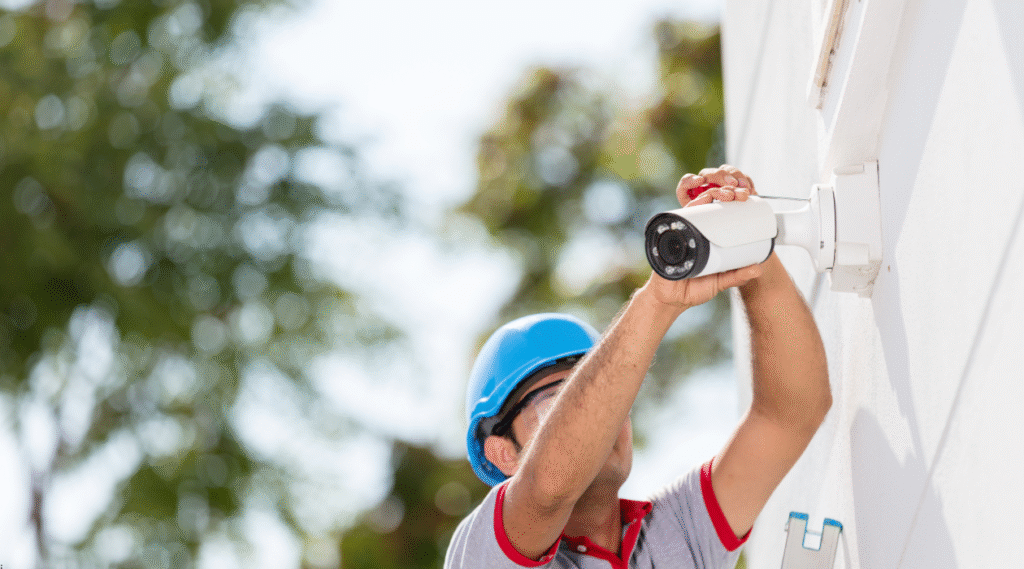In an age where home security is as much about peace of mind as it is about prevention, a strategically designed security camera system is indispensable. Whether you’re safeguarding a cozy bungalow or a sprawling estate, avoiding blind spots and ensuring reliable video surveillance hinges on both savvy electrical work and thoughtful system design. As Walsh Brothers Electric, we’re here to guide you through optimal camera placement, the debate of wired vs. wireless solutions, and seamless smart-home integration, all in a professional yet approachable tone, peppered with clever humor. Let’s dive into a foolproof plan that keeps every corner of your property under watch.
Mapping Your Property for Blind-Spot Elimination
Before drilling holes or running cables, map out your surveillance goals:
- Perimeter Security Needs:
- Identify entry points: front doors, garage entrances, and back gates.
- Highlight common approach paths, driveways, walkways, and patios.
- Identify entry points: front doors, garage entrances, and back gates.
- Interior Hotspots:
- Living areas with valuables or electronics.
- Stairwells and hallways, natural traffic funnels.
- Living areas with valuables or electronics.
- Environmental Considerations:
- Lighting conditions (dawn/dusk glare, outdoor fixtures).
- Obstructions like trees, bushes, or architectural features.
- Lighting conditions (dawn/dusk glare, outdoor fixtures).
Pro Tip: Sketch a simple site plan, marking camera icons at corners with overlapping fields of view. Aim for at least 30% overlap between adjacent cameras to prevent coverage gaps.
Angles & Heights: Mastering Video Surveillance Coverage
The right angle makes all the difference. Follow these placement principles:
- Optimal Height (8–10 feet):
- High enough to avoid tampering.
- Low enough to capture facial details.
- High enough to avoid tampering.
- Downward Tilt (15–25°):
- Prevent sky or ground washout.
- Maintain clear identification of subjects.
- Prevent sky or ground washout.
- Avoid Direct Backlighting:
- Cameras facing windows or bright lights suffer silhouette effects.
- Use side angles or shaded mounts to preserve image quality.
- Cameras facing windows or bright lights suffer silhouette effects.
By combining fixed wide-angle cameras for broad coverage with PTZ (pan-tilt-zoom) units for detailed inspection, you create a layered defense that leaves no blind spot unaddressed.
Powering Your System: Wiring vs. Wireless Security Cameras

Choosing between hardwired and wireless cameras boils down to reliability vs. flexibility:
Hardwired Cameras: The Gold Standard of Reliability
- Pros:
- Uninterrupted Power: No batteries to replace; ideal for 24/7 operation.
- Stable Connection: Ethernet or coax ensures minimal latency and dropouts.
- Uninterrupted Power: No batteries to replace; ideal for 24/7 operation.
- Cons:
- Installation Complexity: Requires electrical work, running cables through walls or attics.
- Higher Upfront Cost: Professional labor and materials add to initial investment.
- Installation Complexity: Requires electrical work, running cables through walls or attics.
Wireless Cameras: Rapid Deployment & Flexibility
- Pros:
- Easy Installation: Mount almost anywhere; ideal for retrofits.
- Portability: Reposition cameras seasonally or if home layout changes.
- Easy Installation: Mount almost anywhere; ideal for retrofits.
- Cons:
- Battery Maintenance: Expect to recharge or replace batteries every few months (or invest in solar-charged units).
- Wi-Fi Dependence: Vulnerable to network congestion or interference.
- Battery Maintenance: Expect to recharge or replace batteries every few months (or invest in solar-charged units).
Hybrid Approach: Combine hardwired power with wireless data (Power-over-Ethernet + Wi-Fi bridge) for best-of-both-worlds performance.
Cable Management & Residential Electric Safety

When opting for wired systems, adhere to electrical codes and best practices:
- Dedicated Circuits:
- Avoid overloading existing lines.
- Use GFCI-protected outlets in damp locations (garages, patios).
- Avoid overloading existing lines.
- Concealed Conduit or Raceway:
- Protect cables against pests and weather.
- Maintain clean, professional aesthetics.
- Protect cables against pests and weather.
- Surge Protection:
- Install surge suppressors to shield cameras and recording equipment from lightning strikes or power spikes.
- Install surge suppressors to shield cameras and recording equipment from lightning strikes or power spikes.
- Professional Installation:
- Our certified electricians ensure wiring meets NEC standards for safety and longevity.
- Our certified electricians ensure wiring meets NEC standards for safety and longevity.
Need expert wiring? Visit our website or call us to schedule a consultation.
Smart-Home App Integration for Remote Monitoring
The era of DVRs buried in closets is over. Today’s systems boast cloud connectivity and mobile apps for real-time peace of mind:
- Key Features to Look For:
- Push Notifications: Instant alerts upon motion or sound detection.
- Two-Way Audio: Communicate with visitors or scare off intruders remotely.
- Cloud Storage: Retain footage off-site to prevent loss if hardware is stolen.
- Push Notifications: Instant alerts upon motion or sound detection.
- Popular Platforms:
- Apple HomeKit & HomeKit Secure Video for seamless iOS integration.
- Google Home & Nest for cross-platform convenience.
- Proprietary Apps offering advanced analytics (face recognition, object detection).
- Apple HomeKit & HomeKit Secure Video for seamless iOS integration.
Setup Tip: Ensure your home Wi-Fi network supports dual-band (2.4 GHz for range, 5 GHz for speed) and has a dedicated SSID for IoT devices to minimize bandwidth contention.
Maintenance & Troubleshooting: Keeping Your Eyes Sharp
A camera system is only as good as its upkeep:
- Biannual Physical Inspections: Check mounts, lenses, and weather seals for damage.
- Firmware Updates: Manufacturers patch security vulnerabilities, apply updates promptly.
- Lens Cleaning: Wipe away dust or spider webs monthly for crisp video quality.
- Network Health Check: Monitor bandwidth usage, signal strength, and device connectivity.
Should you encounter glitchy connections or power flickers, our Walsh Brothers Electric team is just one call away, providing prompt commercial and residential electric troubleshooting.
Conclusion: From Placement to Peace of Mind
Installing security cameras involves more than picking a model off the shelf. Thoughtful blind-spot elimination, judicious choice between wired vs. wireless, and robust smart-home integration form the trifecta of modern home surveillance. Coupled with professional electrical work by Walsh Brothers Electric, you’ll enjoy a system that not only deters intruders but also fits seamlessly into your daily life.
Reach out to us: Have questions or are you ready to upgrade your security? Call 740-777-6699 or visit our website. Let’s illuminate every corner of your property, so you can rest easy, day or night.
